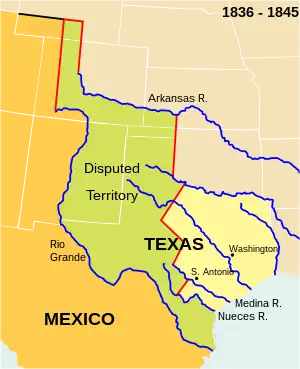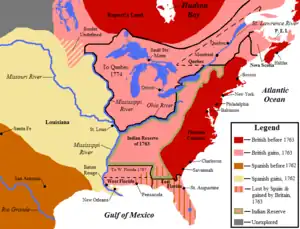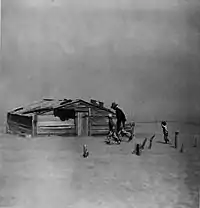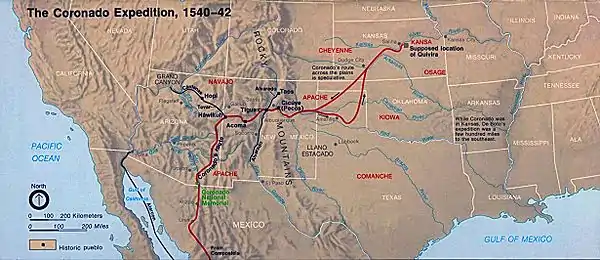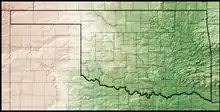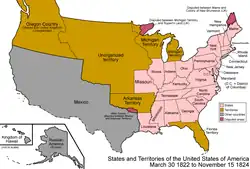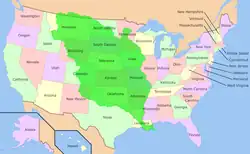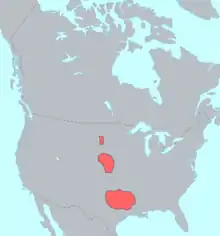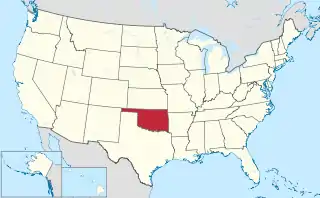The Oklahoma Portal The flag of Oklahoma Oklahoma (/ˌoʊkləˈhoʊmə/ ⓘ; Choctaw: Oklahumma, pronounced [oklahómma]; Cherokee: ᎣᎧᎳᎰᎹ, Okalahoma, pronounced [ògàlàhǒːmã́]) is a state in the South Central region of the United States, bordered by the state of Texas to the south and west, Kansas to the north, Missouri to the northeast, Arkansas to the east, New Mexico to the west, and Colorado to the northwest. Partially in the western extreme of the Upland South, it is the 20th-most extensive and the 28th-most populous of the 50 United States. Its residents are known as Oklahomans and its capital and largest city is Oklahoma City. The state's name is derived from the Choctaw words okla, 'people' and humma, which translates as 'red'. Oklahoma is also known informally by its nickname, "The Sooner State", in reference to the Sooners, settlers who staked their claims in the Unassigned Lands before the Indian Appropriations Act of 1889 authorized the Land Rush of 1889. The land now known as Oklahoma has been inhabited since at least the last ice age. The Southern Plains villagers and the Mississippian people inhabited the area between roughly 800 and 1500. The Southern Plains Panhandle culture developed in the Oklahoma Panhandle in western Oklahoma while the Caddoan Mississippian culture inhabited the eastern parts of the state and included the major settlement of Spiro Mounds. The area was also inhabited by the Wichita people, Tonkawa people, and Caddo people. Between 1300 and 1500, the Plains Apache migrated into the Southern Great Plains (now western Oklahoma). During the 1700s, the Comanche people, Kiowa people, Osage people, and Quapaw people migrated into the region. The first European contact with the region was the Spanish explorer Francisco Vázquez de Coronado in 1541. However, the land was claimed by the Kingdom of France's Louisiana colony and included in the Louisiana Purchase to the United States in 1803. Oklahoma was part of District of Louisiana (1804–1805), Louisiana Territory (1805–1812), Missouri Territory (1812–1821), Arkansas Territory (1819–1828), before finally being designated Indian Territory. In the 1830s, the United States began forcibly removing Native Americans to Indian Territory, with the most famous instance being the deportation of the Five Civilized Tribes (Cherokee, Chickasaw, Choctaw, Muscogee, and Seminole) which became known as the Trail of Tears. During the American Civil War, the Five Tribes formally sided with the Confederate States of America, while some tribal members served in the Union-aligned Indian Home Guard. After the American Civil War, slavery was abolished by treaty in the Five Tribes. Between 1866 and 1899, the cattle trails from Texas to Kansas ran through the territory. The Dawes Act of 1887 began the allotment of most Oklahoma tribes and the Curtis Act of 1898 authorized the allotment of the Five Tribes territory. The Indian Appropriations Act of 1889 authorized the Land Rush of 1889 in the Unassigned Lands of Indian Territory. In 1890, Oklahoma Territory was formed out of the western half of Indian Territory. After an attempt to make Indian Territory into the State of Sequoyah failed in 1905, Oklahoma Territory and Indian Territory were merged into the State of Oklahoma when it became the 46th state to enter the union on November 16, 1907. The 20th century discovery of petroleum led to the development of a powerful oil industry. In the 1910s and 1920s, Oklahoma experienced major instances of civil unrest with the Green Corn Rebellion and the Tulsa Race Massacre. In the 1930s, the Dust Bowl led to mass emigration from the state. Conservation efforts in the state reversed population declines in 1950 and continued through the 1960s. In 1995, the state was the site of one of the largest domestic terror attacks, the Oklahoma City Bombing. In the 21st century, the United States Supreme Court ruled in McGirt v. Oklahoma that the Muscogee Nation reservation was never disestablished. The ruling led to similar rulings regarding the other Five Tribes (Cherokee Nation, Choctaw Nation, Chickasaw Nation, and Seminole Nation of Oklahoma). (Full article...) Selected article The Cherokee are a people from North America, who at the time of European contact in the 1600s, inhabited what is now the Eastern and Southeastern United States. Most were forcibly moved westward to the Ozark Plateau. They were one of the tribes referred to as the Five Civilized Tribes. According to the 2000 U.S. Census, they are the most numerous of the 563 federally recognized Native American tribes in the United States. Of the southeastern Indian confederacies of the late 1600s and early 1700s (Creek, Chickasaw, Choctaw, etc), the Cherokee were one of the most populous and powerful, and were relatively isolated due to their hilly and mountainous homeland. Beginning at about the time of the American Revolutionary War in the late 18th century, divisions over continued accommodation of encroachments by white settlers, despite repeated violations of previous treaties, caused some Cherokee to begin to leave the Cherokee Nation. Many of these dissidents became known as the Chickamauga. Led by Chief Dragging Canoe, the Chickamauga made alliances with the Shawnee and engaged in raids against colonial settlements (see Cherokee–American wars). Some of these early dissidents eventually moved across the Mississippi River to areas that would later become the states of Arkansas and Missouri. Their settlements were established on the St. Francis and the White Rivers by 1800. The Trail of tears displaced the Cherokee's from their ancestral lands in North Georgia and the Carolinas to Oklahoma. In 1887 the Dawes Act broke up the tribal land base. Under the Curtis Act of 1898, Cherokee courts and governmental systems were abolished by the U.S. Federal Government. (Read more . . . ) Spotlight city -Tahlequah (/ˈtæləkwɑː/ TAL-ə-kwah; Cherokee: ᏓᎵᏆ, daligwa [dàlígʷá]) is a city in Cherokee County, Oklahoma located at the foothills of the Ozark Mountains. It is part of the Green Country region of Oklahoma and was established as a capital of the 19th-century Cherokee Nation in 1839, as part of the new settlement in Indian Territory after the Cherokee Native Americans were forced west from the American Southeast on the Trail of Tears. The city's population was 15,753 at the 2010 census, an increase of 8.96 percent over the figure of 14,458 reported in 2000. The 2019 estimated population is 16,819. (Full article...)Selected picture Credit: Jack Dykinga Oklahoma's state mammal, the American Bison. Featured content
Featured lists: Oklahoma birds • Tallest buildings in Tulsa • List of tallest buildings in Oklahoma City • List of birds of Oklahoma • List of Oklahoma Sooners football seasons • List of Oklahoma Sooners head football coaches • List of Oklahoma Sooners in the NFL Draft State facts Oklahoma State Capitol building
State symbols The Scissortail Flycatcher, Oklahoma's state bird
Selected biography William Bradley "Brad" Pitt, born December 18, 1963 in Shawnee, Oklahoma, is an American actor, film producer, and social activist. He became famous during the mid 1990s after starring in several major Hollywood films. Pitt received a Golden Globe Award and an Academy Award nomination for his role in the 1995 film Twelve Monkeys. Pitt is consistently cited by popular media as one of the most attractive men alive and is regarded as a Hollywood A-lister. His former marriage to actress Jennifer Aniston and current relationship with actress Angelina Jolie have been widely covered in the world media. He is the father of four children with Jolie, one biological, all of whom have also received media coverage. Since his connection with Jolie, he has become increasingly involved in social issues, both domestically and internationally. In 1988, Pitt had his first starring role, in The Dark Side of the Sun, where he played a young American taken by his family to the Adriatic to find a remedy for a skin condition. The movie was shot in Yugoslavia in the summer of '88 with Pitt being paid $1,523 per week for seven weeks. However, with editing nearly complete, war broke out and much of the footage was lost; the film was released years later. Pitt won a part in the TV movie Too Young to Die?, about an abused teenager given the death penalty for murder. Pitt played the part of a drug addict, Billy Canton, who took advantage of a runaway played by Juliette Lewis. (Read more...) Did you know -
General images -The following are images from various Oklahoma-related articles on Wikipedia.
Related portalsWikiprojects
Things you can do
Oklahoma topicsCategoriesCategory puzzle Select [►] to view subcategories
Oklahoma Oklahoma-related lists Communications in Oklahoma Oklahoma culture Demographics of Oklahoma Economy of Oklahoma Education in Oklahoma Environment of Oklahoma Geography of Oklahoma Government of Oklahoma Health in Oklahoma History of Oklahoma Oklahoma law Military in Oklahoma Missing person cases in Oklahoma Native American tribes in Oklahoma People from Oklahoma Politics of Oklahoma Professional wrestling in Oklahoma Science and technology in Oklahoma Oklahoma society Sports in Oklahoma Tourist attractions in Oklahoma Transportation in Oklahoma Works about Oklahoma Images of Oklahoma Oklahoma stubs New articlesThis list was generated from these rules. Questions and feedback are always welcome! The search is being run daily with the most recent ~14 days of results. Note: Some articles may not be relevant to this project.
Rules | Match log | Results page (for watching) | Last updated: 2024-01-16 22:31 (UTC) Note: The list display can now be customized by each user. See List display personalization for details.
Associated WikimediaThe following Wikimedia Foundation sister projects provide more on this subject:
Discover Wikipedia using portals
|


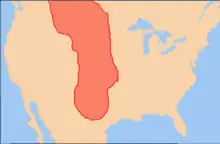
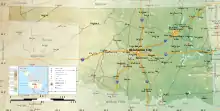
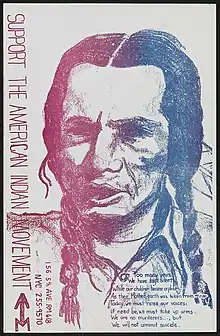


![Image 6Cartoonist's rendering of Theodore Roosevelt's initial reaction to the Oklahoma Constitution.[needs context] (from History of Oklahoma)](../I/Teddyrooseveltoklahomaconstitution.png.webp)


